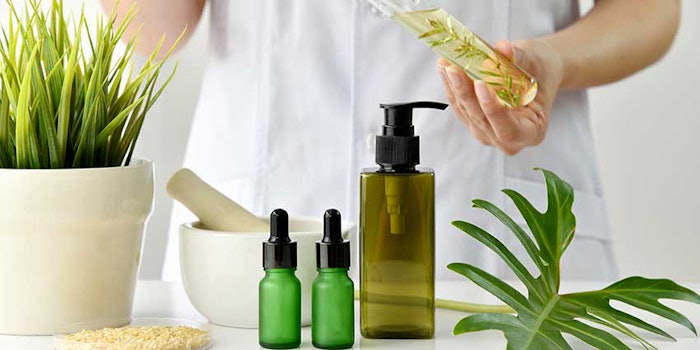
In recent years, questions regarding the use of synthetic preservatives such as parabens have been raised and their safety and possible associated risks to human health challenged.1, 2 Therefore, the market has started asking for preservative-free cosmetics. However, due to the composition of many cosmetic formulations and especially due to the presence of water, microbes can grow if preservatives are not added. So the challenge of producing cosmetics preservatives free is high.
The way to approach this challenge came from the food industry. “Hurdle Technology” has been used to control product safety in the food industry since the 1970s. It consists of creating obstacles during the finished product development—from formulation to packaging to manufacturing—to deteriorate and finally inhibit microbial growth.3 This technology has been tested recently in building preservative-free cosmetics. By working at a certain pH, limiting the “free water” availability, using specific packaging and selecting natural ingredients with proven, anti-microbial capacity, it is possible today to create a preservative-free cosmetic, but containing natural extracts or oils with preservative-like capacity4 (See Figure 1).
The use of herbal extracts, essential oils and other natural products to help preserve cosmetic products has been documented in vitro.5 Yet their use presents challenges of their own: problems associated to color change, odor development, emulsion stability (due to the need of using a rather high dose of the ingredients) and finally, a relatively higher cost in use compared to synthetics. These issues strongly limit the application of natural ingredients in cosmetics for preservation5, 6 ). However, reports of stable formulations using combinations of natural extracts have been documented.6
Herbal Extracts
Traditional medicine is an important application of herbal extracts containing antimicrobial compounds. Local use of certain extracts to disinfect or avoid the growth of microorganisms during wound healing, but also preserving certain food, is common when drugs are not available or their use is not recommended. Analytical investigation of these herbal extracts can prove the nature of these compounds, therefore creating the possibility to consistently produce extracts titered or concentrated for that compound to ensure similar antimicrobial power over time.
It is indeed this route that would eventually solve the issues related to extract color, smell and cost. A more concentrated extract with a more specific ingredients profile, tailored for targeted antimicrobial effect, can increase its efficacy and remove the smell and color. Some examples of herbal extracts tested in cosmetic formulations for their anti-microbial efficacy are presented.
Example 1 – Sylvan Strawberry
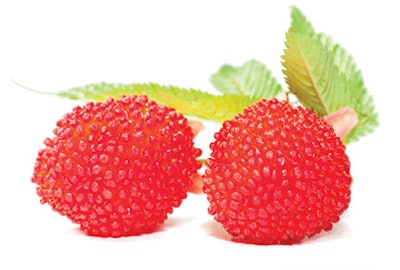 Rubus rosaefolius, is a shrub native to rainforests, popularly known as sylvan strawberry. Hydro-alcoholic extraction followed by concentration steps produced an extract particularly rich in saponins and heterosides (leaves). This extract showed antimicrobial properties when tested in vitro.7 When it was introduced at 0.2 percent (w/w) in a gel or an emulsion, the formulations were protected from bacteria and yeast, although they failed to be protected against fungi.8
Rubus rosaefolius, is a shrub native to rainforests, popularly known as sylvan strawberry. Hydro-alcoholic extraction followed by concentration steps produced an extract particularly rich in saponins and heterosides (leaves). This extract showed antimicrobial properties when tested in vitro.7 When it was introduced at 0.2 percent (w/w) in a gel or an emulsion, the formulations were protected from bacteria and yeast, although they failed to be protected against fungi.8Example 2 – Honeysuckle
Lonicera japonica, commonly known as honeysuckle, has a history of medical remedy. The flower extract has shown anti-microbial properties at concentrations as low as 0.1 percent.9
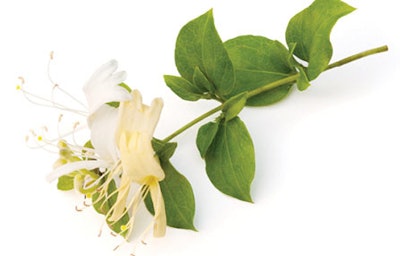 The presence of p-hydroxy benzoic acid—a natural paraben—can be the reason for the extract’s anti-microbial properties.10 Formulations such as emulsions and shampoos containing Lonicera japonica extract at 0.2 percent showed anti-microbial protection.4 However, if the extract was not combined with other anti-microbial systems such as glyceryl caprylate and/or levulinic acid, p-anisic acid and ethanol, it failed to protect against fungi.6
The presence of p-hydroxy benzoic acid—a natural paraben—can be the reason for the extract’s anti-microbial properties.10 Formulations such as emulsions and shampoos containing Lonicera japonica extract at 0.2 percent showed anti-microbial protection.4 However, if the extract was not combined with other anti-microbial systems such as glyceryl caprylate and/or levulinic acid, p-anisic acid and ethanol, it failed to protect against fungi.6Essential Oils
Essential oils are used to enhance the appeal of cosmetic products, bringing a distinctive scent along with protecting and soothing properties to the skin.11 Many papers have shown essential oils or their terpenes possess anti-microbial properties in vitro and they have been extensively used in natural formulations to hurdle microbial growth.5 However, essential oils, when compared to synthetic preservatives such as methyl parabens, need to be used at very high concentrations (sometimes up to six times more) and are micro-organism specific.5 This means a combination of essential oils is needed. The high concentration brings too strong of a scent, which may destabilize the emulsion and can cause dermatological allergies.5
As for the herbal extracts, it is important to build a formulation containing combinations at low concentrations of each natural ingredient and carefully test this combination in challenge tests protocols. Some examples of essential oils tested in cosmetic formulations for their anti-microbial efficacy are presented.
Example 1 – Thyme Oil
Thyme oil from Thymus vulgaris is often used in cosmetic formulations for its purifying properties.
Thyme essential oil has shown anti-microbial capabilities, probably associated to its components thymol and carvacrol.12, 13 These phenols are believed to disrupt micro-organism cell membrane. When tested in cosmetic formulation at a concentration of 3 percent (w/w), the essential oil was able to inhibit most challenge tests related to micro-organisms, but it failed against fungi.14
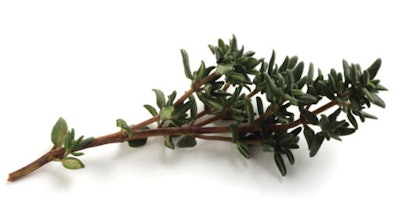 Example 2 - Tea Tree Oil
Example 2 - Tea Tree OilTea tree oil from the leaves of Melaleuca alternifolia has shown anti-microbial properties and has been incorporated in hand-washing formulations or as disinfectants to treat acne and
 minor wounds. The presence of terpinen-4-ol is associated with the essential oil efficacy. As many essential oils do, the highest percentage of the active components produces its highest efficacy, but unfortunately it also creates the maximum irritation potential.15 Tea tree oil has been shown to be active at concentrations as low as 0.5 percent (w/w) to preserve cosmetic products while minimizing its irritation potential.16
minor wounds. The presence of terpinen-4-ol is associated with the essential oil efficacy. As many essential oils do, the highest percentage of the active components produces its highest efficacy, but unfortunately it also creates the maximum irritation potential.15 Tea tree oil has been shown to be active at concentrations as low as 0.5 percent (w/w) to preserve cosmetic products while minimizing its irritation potential.16Natural Additives to Boost Preservation
Sorbic acid (from Sorbus aucuparia unripe berries) is used against fungi growth. It is an essential ingredient to combine with natural preservatives, as many herbal extracts and essential oils are too weak to protect against fungi.10
Phytic acid (from rice bran) is a chelating agent, which can enhance preservative anti-microbial efficacy. Its advantage is its biodegradability.10
Natural Byproducts as Sustainable Preservatives
1. Olive Oil Mill Waste Water/Olive Oil Pomace and Cake
Production of extra-virgin olive oil (Olea europaea) generates a large quantity of waste; mainly olive oil mill waste water, olive pomace and filter cake. These byproducts have been
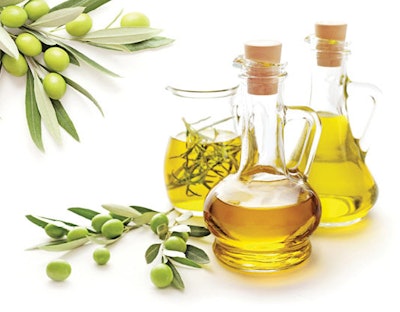 investigated as a sustainable source of phenolic compounds.17, 18 Interestingly, the phenolic fraction of olive oil contains only 2 percent of the total phenols of the olive fruit, with the residual 98 percent lost in olive mill waste.19 Procedures have been put in place to recover most of the antioxidants and concentrate them, such as hydroxy-tyrosol.17 A fraction isolated from olive mill waste water after ethanol extraction—containing mainly hydroxytyrosol, verbascoside and tyrosol—is able to completely inhibit growth of Gram positive and Gram negative bacteria,20 suggesting the use of olive oil production byproducts for natural preservation.
investigated as a sustainable source of phenolic compounds.17, 18 Interestingly, the phenolic fraction of olive oil contains only 2 percent of the total phenols of the olive fruit, with the residual 98 percent lost in olive mill waste.19 Procedures have been put in place to recover most of the antioxidants and concentrate them, such as hydroxy-tyrosol.17 A fraction isolated from olive mill waste water after ethanol extraction—containing mainly hydroxytyrosol, verbascoside and tyrosol—is able to completely inhibit growth of Gram positive and Gram negative bacteria,20 suggesting the use of olive oil production byproducts for natural preservation.2. Spent Turmeric Oleoresin
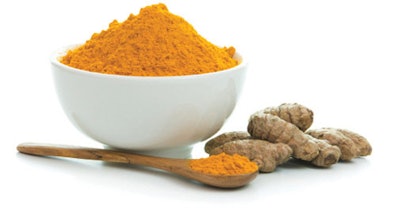 Turmeric root (Curcuma longa) and its curcuminoids have shown antimicrobial activity.21 To produce curcuminoids from turmeric root, an oleoresin is first obtained and curcuminoids are isolated. The mother liquor, after partial isolation of curcuminoids, is known as spent turmeric oleoresin (STO), which is considered industrial waste, but it is rich in antioxidants and antimicrobial compounds.22 It can be further purified by hexane extraction to obtain a turmeric oil fraction rich in turmerone. Turmeric oil from STO has shown antimicrobial properties against both bacteria23 and fungi24, suggesting it as a promising ingredient for natural preservation.
Turmeric root (Curcuma longa) and its curcuminoids have shown antimicrobial activity.21 To produce curcuminoids from turmeric root, an oleoresin is first obtained and curcuminoids are isolated. The mother liquor, after partial isolation of curcuminoids, is known as spent turmeric oleoresin (STO), which is considered industrial waste, but it is rich in antioxidants and antimicrobial compounds.22 It can be further purified by hexane extraction to obtain a turmeric oil fraction rich in turmerone. Turmeric oil from STO has shown antimicrobial properties against both bacteria23 and fungi24, suggesting it as a promising ingredient for natural preservation.3. Lavender Hydrosol
 During plant material distillation, herbal waters called hydrosols or hydrolates are obtained. These hydrosols can be applied directly onto the skin, bringing a cooling, hydrating and soothing effect25 and unlike essential oil, they will not cause irritation. As essential oil is of primary interest, the hydrosols are undesirable byproducts and are considered waste. However, more recently the hydrosols have become popular, especially in natural-based cosmetic products as the water base.
During plant material distillation, herbal waters called hydrosols or hydrolates are obtained. These hydrosols can be applied directly onto the skin, bringing a cooling, hydrating and soothing effect25 and unlike essential oil, they will not cause irritation. As essential oil is of primary interest, the hydrosols are undesirable byproducts and are considered waste. However, more recently the hydrosols have become popular, especially in natural-based cosmetic products as the water base.This renewed interest is associated to the hydrosols’ properties on skin and also to their antimicrobial capacity, which was previously documented. 26, 27 Hydrosols contain ingredients present in the respective essential oils, as well as water soluble ones.25, 28 Lavender (Lavandula angustifolia) hydrosol contains 22 to 38 identified compounds with linalool as its main ingredient.28 By using the lavender hydrosol to replace water in a moisturizing body gel, significant antimicrobial protection can be achieved against both bacteria and fungi.28
Hydrosols can be an interesting way to preserve naturally. However, the dilution of the hydrosol can be key to its performance, suggesting the need to measure the concentration of its main compounds to obtain a reproducible preservation effect.
Conclusions
Although it is challenging today to produce a cosmetic product containing water that is free of chemical preservatives, relying solely on natural preservation is not out of the question. Many natural ingredients on the market can be combined to achieve a naturally preserved product.
It is clearly a formulation effort to make sure everything has been addressed to hurdle microbial growth in these products. The ability to use natural byproducts to address natural preservation of cosmetics is an exciting sustainable approach to reduce waste and recycle ingredients with added benefits.
References
- Handa O, Kokura S, Adachi S, Takagi T, Naito Y, Tanigawa T, Yoshida N, Yoshikawa T. Methylparaben potentiates UV-induced damage of skin keratinocytes. Toxicology 227(1-2): 62-72, 2006
- Lemini C, Jaimez R, Avila ME, Franco Y, Larrea F, Lemus AE. In vivo and in vitro estrogen bioactivities of alkyl parabens. Toxicol Ind Health 19 (2–6): 69-79 (2003).
- Rahman MS. Hurdle technology in food preservation. In: Minimally processed food. Siddiqui MW, Rahman MS (Eds.). Springer, 2015
- Varvaresou A, Papageorgiou S, Tsirivas E, Protopapa E, Kintziou H, Kefala V, Demetzos C. Self-preserving cosmetics. Int J Cosmet Sci 31(3): 163-175, 2009
- Herman A, Herman AP, Domagalska BW, Młynarczyk A. Essential oils and herbal extracts as antimicrobial agents in cosmetic emulsion. Indian J Microbiol 53(2): 232-237, 2013
- Papageorgiou S, Varvaresou A, Tsirivas E, Demetzos C. New alternatives to cosmetics preservation. J Cosmet Sci 61(2): 107-123, 2010
- Mauro C, Cardoso CMZ, Schultze C, Yamamichi E, Lopes PS, Marcondes EMC, Miranda JP, Arruda DAO, Frota M, Pacheco AL. Estudo botânico, fitoquímico e avaliação da atividade antimicrobiana de R. rosaefolius Sm., Rosaceae. Rev Bras Farmacogn 12: 23–25, 2002
- Ostrosky EA, Marcondes EM, Nishikawa Sde O, Lopes PS, Varca GH, Pinto Tde J, Consiglieri TV, Baby AR, Velasco MV, Kaneko TM. Rubus rosaefolius extract as a natural preservative candidate in topical formulations. AAPS PharmSciTech 12(2): 732-737, 2011
- Kong B, Wang J, Xiong YL. Antimicrobial activity of several herb and spice extracts in culture medium and in vacuum-packaged pork. J Food Prot 70: 641–647, 2007
- Dweck AC. An update on natural preservatives. Personal Care 9: 11-15, 2005
- Miguel MG. Antioxidant and anti-inflammatory activities of essential oils: a short review. Molecules 15(12): 9252-9287, 2010
- Pianizzi L, Flamini G, Gion PL, Morelli I. Composition and antimicrobial properties of essential oils of four Mediterannean Lamiaceae. J Ethnopharmacol 39: 167–170, 1993
- Nostro A, Papalia T. Antimicrobial activity of carvacrol: current progress and future prospectives. Recent Pat Antiinfect Drug Discov 7(1): 28-35, 2012
- Manou I, Bouillard L, Devleeschouwer MJ, Barel AO. Evaluation of the preservative properties of Thymus vulgaris essential oil in topically applied formulations under a challenge test. J Appl Microbiol 84(3): 368-376, 1998
- Carson CF, Riley TV. Antimicrobial activity of the major components of the essential oil of Melaleuca alternifolia. J Appl Bacteriol 78: 264–269, 1995
- Priest D. Preserving naturally with Tea tree oil. SOFW J 121: 486–489, 1995
- Kalogerakis N, Politi M, Foteinis S, Chatzisymeon E, Mantzavinos D. Recovery of antioxidants from olive mill wastewaters: a viable solution that promotes their overall sustainable management. J Environ Manage 128: 749-758, 2013
- Frankel E, Bakhouche A, Lozano-Sánchez J, Segura-Carretero A, Fernández-Gutiérrez A. Literature review on production process to obtain extra virgin olive oil enriched in bioactive compounds. Potential use of byproducts as alternative sources of polyphenols. J Agric Food Chem 61: 5179–5188, 2013
- Rodis PS, Karathanos VT, Mantzavinou A. Partitioning of olive oil antioxidants between oil and water phases. J Agric Food Chem 50(3): 596-601, 2002
- Tafesh A, Najami N, Jadoun J, Halahlih F, Riepl H, Azaizeh H. Synergistic antibacterial effects of polyphenolic compounds from olive mill wastewater. Evid Based Complement Alternat Med 2011: 431021, 2011
- Rachana S, Venugopalan P. Antioxidant and bactericidal activity of wild turmeric extracts. J Pharmacogn Phytochem 2(6): 89-94, 2014
- Nagarajan S, Kubra IR, Rao LJ. Separation of curcuminoids enriched fraction from spent turmeric oleoresin and its antioxidant potential. J Food Sci 75(6): H158-62, 2010
- Negi PS, Jayaprakasha GK, Jagan Mohan Rao L, Sakariah KK. Antibacterial activity of turmeric oil: a byproduct from curcumin manufacture. J Agric Food Chem 47(10): 4297-4300, 1999
- Jayaprakasha GK, Negi PS, Anandharamakrishnan C, Sakariah KK. Chemical composition of turmeric oil--a byproduct from turmeric oleoresin industry and its inhibitory activity against different fungi. Z Naturforsch C 56(1-2): 40-44, 2001
- Catty S. Hydrosols: The Next Aromatherapy. Healing Arts Press, Rochester, VT, 2001
- Tornuk F, Cankurt H, Ozturk I, Sagdic O, Bayram O, Yetim H. Efficacy of various plant hydrosols as natural food sanitizers in reducing Escherichia coli O157:H7 and Salmonella Typimurium on fresh cut carrot and apples. Int J Food Microbiol 148(1): 30–35, 2011
- Hussien J, Teshale C, Mohammed J. Assessment of the antimicrobial effect of some Ethiopian aromatic spice and herb hydrosols. Int J Pharmacol 7: 635–640, 2011
- Kunicka-Styczy´nska A, ´Smigielski K, Prusinowska R, Rajkowska K, Ku´smider B, Sikora M. Preservative activity of lavender hydrosols in moisturizing body gels. Lett Appl Microbiol 60(1): 27-32, 2015










